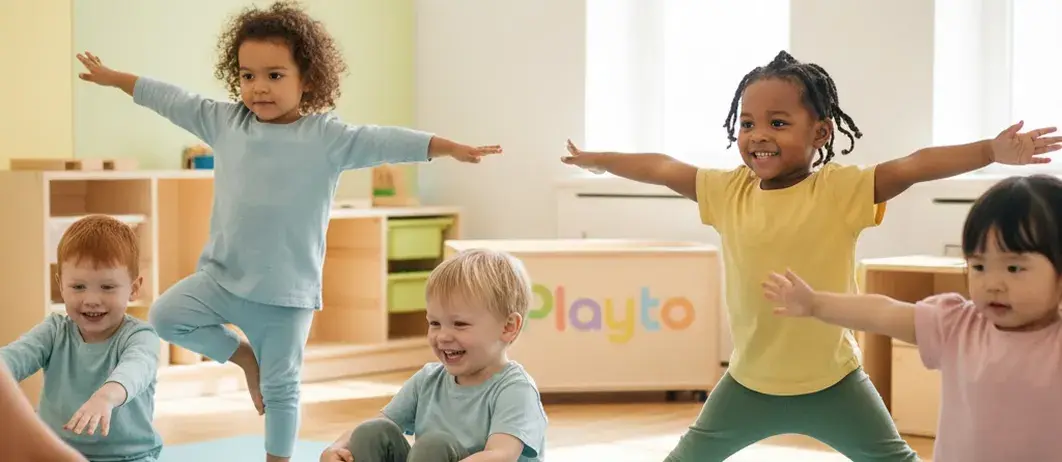November 10, 2025
Why yoga for toddlers — and why now?

Supporting Early Development Through Movement
Toddlers are sprinting through a critical window of brain and body development. At the same time, modern life brings more stimulation, more screens, and earlier structured expectations. Yoga fits this moment because it meets young children where they are: curious, wiggly, playful — and learning how to navigate big feelings with small vocabularies.
In toddler-friendly classes, yoga looks like stories, songs, animal poses, and simple breathing. It’s not competitive, it’s not about flexibility contests, and it’s not about sitting still. It’s a safe, fun container that channels energy into strength, balance, coordination, attention, and self-regulation. The upside compounds: kids internalize habits that make school transitions smoother, friendships easier, and daily routines calmer.
The best reason to start early: toddlers learn that body, breath, and feelings are connected — a lesson that pays off for decades.
Physical development: strong bodies without pressure
During the toddler years, motor skills are rapidly wiring. Yoga’s intentional movements help that wiring mature in balanced ways:
-
Balance & coordination:
Poses like Tree, Boat, or Downward Dog engage both sides of the body and the vestibular system, improving stability and spatial awareness.
-
Functional strength:
Weight-bearing through hands and feet builds joint stability and core strength without strain or impact.
-
Natural flexibility:
Gentle, playful stretches keep growing muscles supple without the risk of overextension that can happen in competitive settings.
-
Body awareness:
Naming body parts and shapes (“tall mountain,” “wide star,” “small seed”) builds proprioception — kids learn where their body is in space and how to move it on purpose.

Emotional skills: tools for big feelings
Toddlers have adult-sized emotions and beginner-level regulation. Yoga gives them simple, repeatable tools:
-
Breathing to calm:
Smell the flower, blow the candle” turns diaphragmatic breathing into a game. Slow exhalations cue the nervous system to settle.
-
Pause & notice:
Short rests between poses teach kids to check in: “How does your body feel now? Is your heart fast or slow?” That’s interoception — reading internal signals.
-
Focus in motion:
Tiny sequences (three or four poses) build sustained attention. That translates to listening, following directions, and smoother transitions.
-
Confidence:
Mastering a pose — any pose — delivers a sense of “I can do hard things,” which becomes a generalized growth mindset.

Social growth: play, patience, cooperation
Toddler yoga classes are interactive by design. Children mirror the teacher, take turns, and celebrate each other’s attempts. Many programs weave storytelling so kids “become” animals or nature shapes, which keeps engagement high while reinforcing social norms:
-
Turn-taking & listening:
Waiting for the next pose or sharing props builds patience without shaming.
-
Communication:
Story-driven prompts (“Can you show a brave lion?”) encourage expressive movement and vocabulary.
-
Caregiver bonding:
In parent-and-tot formats, you model calm and co-regulation. Kids borrow your nervous system — yoga makes that borrowing intentional.
.webp?width=1062&height=462&name=Rectangle%2034624257%20(1).webp)
Long-term impact: resilience and self-awareness
Early yoga plants seeds that keep producing. As children enter preschool and kindergarten, the benefits show up in practical ways: easier transitions, improved attention during circle time, and faster recovery from frustration. In later years, those seeds look like study stamina, test-day nerves that don’t derail performance, and healthier coping strategies under social pressure.
Three durable outcomes to expect
-
Mind–body connection:
Kids learn that breath can change how they feel. That’s a life skill, not a phase.
-
Healthy coping mechanisms:
Instead of defaulting to avoidance or outbursts, children have accessible, non-harmful tools: pause, breathe, move, reset.
-
Self-efficacy:
Small wins on the mat compound into “I can try, learn, and improve” — the foundation of resilience.
How to reinforce yoga at home (no expertise required)
You don’t need a studio or special gear. Consistency beats complexity:
-
Two-minute rituals:
After waking or before bed, do a tiny flow: Mountain → Star → Forward Fold → Seed (child’s pose). Add three slow breaths.
-
Breath cues:
Use playful scripts: “Smell the hot cocoa… cool it down.” Make exhale longer than inhale.
-
Calm corner:
A mat, a pillow, and a feelings chart. Visit it after big emotions — not as punishment, but as a tool station.
-
Yoga storytime:
Choose books or short videos that pair poses with narratives. Let your child “teach” you their favorite move.
.webp?width=1062&height=462&name=Rectangle%2034624257%20(2).webp)